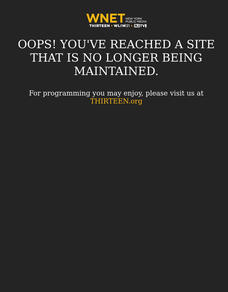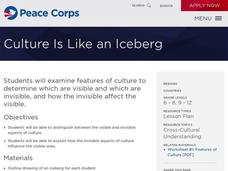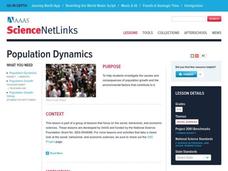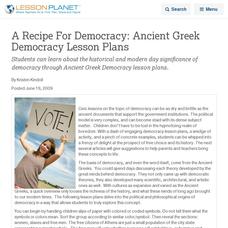Curated OER
We Are What We Remember
Students engage in research, small-group discussions, whole class discussions, family interviews, and interaction with multimedia resource material as they explore the relationship between memory and history.
Channel Islands Film
Human Impact on the Food Web of Santa Cruz Island
What happens when a non-native species is introduced onto an island? Santa Cruz Island, part of the Channel Island chain located off the coast of southern California, provides the perfect laboratory for young environmental scientists to...
US Institute of Peace
Identifying Elements of Conflict
What lies at the heart of a conflict? Help pupils peel back the layers during an in-depth study of the elements of conflict. A instructional activity addressing peacekeeping and conflict management examines the historical, emotional, and...
Tennessee State Museum
Deciphering the Document: Unlocking the Meaning of the Emancipation Proclamation
Help your learners truly understand the Emancipation Proclamation by asking them the put it into their own words. After reading the document out loud to the class, and briefly discussing the legal language, split your class into small...
Los Angeles Unified School District
Capitalism and Socialism
Capitalism, socialism, communism ... these may seem like a whole bunch of isms to your scholars. High schoolers won't confuse them after completing an informative resource. Your class masters how to use primary sources to...
Curated OER
Culture, Race & Ethnicity
Is there a difference between culture, race, and ethnicity? In order to celebrate Harmony Day and cultural diversity, your class will brainstorm, discuss, and discover that there is. The class splits into three groups, each group is...
What So Proudly We Hail
Life, Liberty, and the Pursuit of Happiness: A Lesson on the Declaration of Independence
What does it mean to say that a right is unalienable? How did the founding fathers convey this revolutionary concept in the Declaration of Independence? Engage in a close reading and analysis of the Declaration of Independence, and...
Curated OER
Culture is Like An Iceberg
Students examine the different features of culture. They determine which features are visible and invisible. They describe how the two types affect each other.
Curated OER
Culture Is Like an Iceberg
Students examine features of culture to determine which are visible and which are invisible, and how the invisible affect the visible. They look at both their outline drawing of the iceberg and their Features of Culture worksheet and...
Curated OER
Where in the World? The Basics of Latitude and Longitude
Students are introduced to the concepts of latitude and longitude. In groups, they identify the Earth's magnetic field and the disadvantages of using compasses for navigation. They identify the major lines of latitude and longitude on a...
The New York Times
Decision Point: Understanding the U.S.’s Dilemma Over North Korea
Simulate the Situation Room and analyze the US's relationship with North Korea. The plan starts off with a quick review and an examination of a online timeline that updates as the situation continues. Next, the class reads an article and...
Theodore Roosevelt Association
Theodore Roosevelt: A Presidential Timeline
Throughout his life and presidency, Theodore Roosevelt contributed to the America we know today in so many ways. An adaptable lesson prompts young historians to create a chronological timeline of Roosevelt's contributions to different...
iCivics
Win the White House
Here is a unique and engaging approach to learning about the steps a presidential candidate must take during a campaign. Learners role play the part of a candidate in this online interactive, taking part in a presidential...
Curated OER
Saskatchewan Agriculture: Importance and Impact
Learners explore the Saskatchewan farming community. For this agriculture lesson, students have an online discussion about the agriculture in Saskatchewan. They discuss various topics that are related to soil degradation, world hunger,...
Curated OER
Population Dynamics
Students investigate the causes and consequences of population growth and the envrionmental factors that contribute to it. They discuss what they think the world's population will be in 2050.
Curated OER
Persuasion as Text: Organizational, Grammatical, and Lexical Moves in Barbara Jordan’s "All Together Now"
A thorough lesson plan on persuasive writing takes middle schoolers through several activities, including group discussion, collaborative posters, and independent writing. They compare historical speeches and analyze the persuasive...
Curated OER
Culture Is Like an Iceberg
Students examine cultural traditions. In this culture lesson plan, students compare invisible and visible features of culture as they complete an iceberg-themed worksheet.
Curated OER
Breaking News English: Earthquake in Pakistan
In this earthquake in Pakistan worksheet, students read the article, answer true and false questions, complete synonym matching, complete phrase matching, complete a gap fill, answer short answer questions, answer discussion questions,...
Curated OER
A Recipe For Democracy: Ancient Greek Democracy Lesson Plans
Students can learn about the historical and modern day significance of democracy through Ancient Greek Democracy lesson plans.
Curated OER
Discipline and Punish
In this online interactive philosophy worksheet, students respond to 10 short answer and essay questions about Discipline and Punish by Foucault. Students may check some of their answers on the interactive...
Curated OER
World History: Why Civilizations Fall
Students examine factors leading to the demise of ancient civilizations. They list causes that led to the downfall of these societies. Students conduct Internet research and participate in online archaeological investigations.
Curated OER
Ecosystems
Students role play as members of interest group with a stake in a local land use issue. In preparation for the town hall meeting, students research their issue and gather pertinent information to persuade their audience.





















